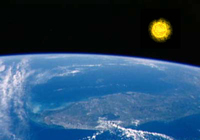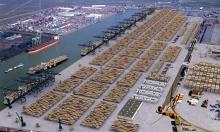Earth to go splat on the Sun like bugs on windshield
Researchers at the European Southern Observatory suggested that planets could go splat against their stars like bugs on a windshield. The researchers put forth their theory after examining the spectrum of the stellar systems located next to the Sun.

The planets’ orbits are upset by gravitational disturbances caused by the impact of parent stars. The disturbances may as well be due to other reasons that remain to be seen. As a result, the planets fall into the fiery pits of hell. The majority of planets in the vicinity of their parent stars are doomed for destruction. Earth may be destroyed in a similar fashion, reports RBC Daily.
The first hypotheses about possible destruction of exoplanets by parent stars emerged after the discovery of those exoplanets or worlds orbiting distant stars. Thus far more than 200 exoplanets have been discovered. Nearly all of them are gaseous giants akin to Jupiter-like planets. They have a very short orbit period (several days) as they spin around their stars.
Researchers who have been trying to investigate the stars’ makeup by analyzing their radiation spectra found out that the young stars were exceedingly rich in metals. The findings contradicted the previous estimates.
“Cannibalism of the parent stars could probably explain the phenomenon,” said European Southern Observatory astronomer Luca Pasquini. “Stars that host planets eat them up. As a result, a planet’s vaporized matter goes splattering on the surface of a star. In a way, it’s like bugs going splat on a windshield,” Pasquini added.
“Planets collide with their parent stars, which bear the marks of collision on their surface. So the stars’ spectra reveal the presence of metals. It is a little bit like a cappuccino. There is cocoa powder only on the top,” Pasquini said.
To gather more evidence, European Southern Observatory researchers also looked into red giants, which were nearing the end of their life cycle. Sun-like stars (in terms of a star’s mass) end up like red giants. Red giants puff up significantly as their luminosity increases. Then the stars become cooler and turn into white dwarves. After inspecting 14 planet-hosting red giants, Pasquini and his colleagues found those stars were not as rich in metals as planet-hosting sun-like stars.
According to Pasquini, planetary debris was scattered all over the stars following the collision; that is why it remains unseen for spectrometers. This does not occur in young stars whose convective currents are fairly small and residual matter circulates through the surface for millions of years.
“Star cannibalism is well-known phenomenon,” said Dmitry Bisikalo, deputy director of the Institute of Astronomy under the Russian Academy of Scientists. “As regards double stellar systems, one star may engulf swallow up another one. However, we still have to learn more about the processes occurring in planets. The theory offered by our European colleagues has plenty of gaps to be filled with information. That is why many scientists are skeptical about it,” Bisikalo added.
The theory is viewed with suspicion because stellar systems have existed for billions of years. Planets’ orbits stabilized and no force seems to be capable of making planets decay from their orbits. Stars, without doubt, actively assimilated planetary matter as planets were forming in earlier times.
“Some double stellar systems shoot off their planets now and then,” said Alexander Tutukov, head of the department of physics and evolution of stars at the Institute of Astronomy under the Russian Academy of Sciences. “Planets in the double stellar systems sometimes change their orbits because of some factors related to gravitational waves of the systems. Such planets accelerate in a gravitational field and break loose,” Tutukov said.
“There are a large number of such planets traveling across the Galaxy. They are always on the move, flying in space at 30 kilometers per second. They can normally resist the attraction caused by other stellar systems. But sometimes they may collide with stars, leaving marks on the surface.” Tutukov added.
Stars also actively engulf planets before fading to black. “At the time of their dying, stars devour their children,” said Tutukov. “For instance, stars eat up one star in the galaxy each year. The sun will puff up in several billion years too. The sun will become much larger; reaching the orbits of Mercury, Venus, and, finally, its mass will reach the orbit of Earth. Doom and destruction will face these planets; high temperatures will cause them to vaporize even before they collide with the sun. Mars will be destroyed too. However, the sun will ‘choke’ on Jupiter, which is too massive for the sun to swallow it. The heavy Jupiter will cut the sun open, and our star will turn into a white dwarf in the end,” Tutukov concluded.
Ufolog.ru
Translated by Guerman Grachev
Pravda.ru
Subscribe to Pravda.Ru Telegram channel, Facebook, RSS!




